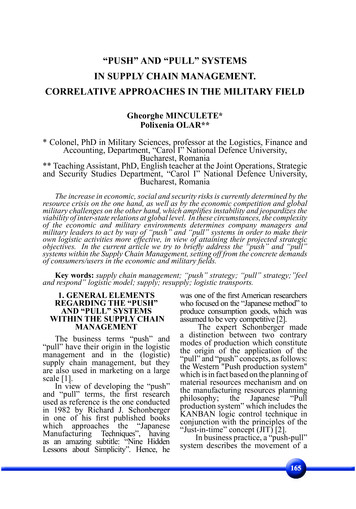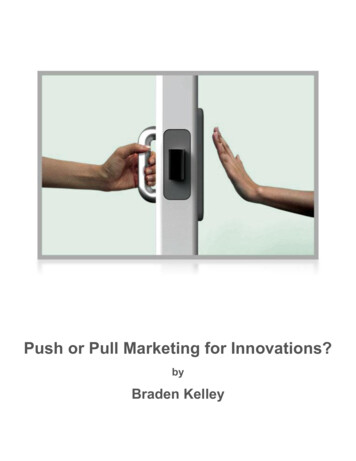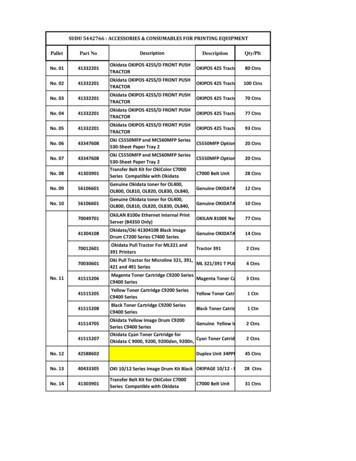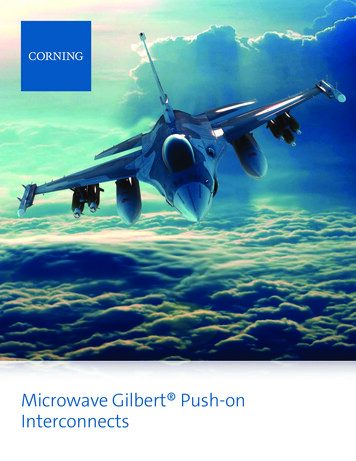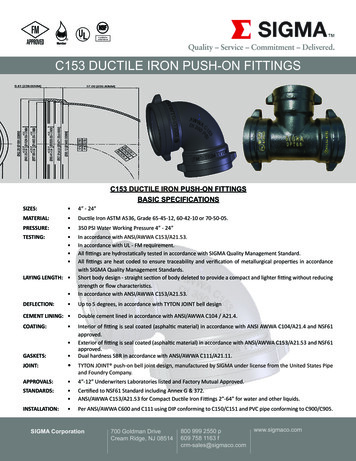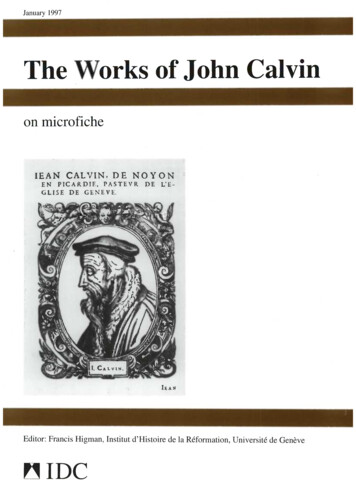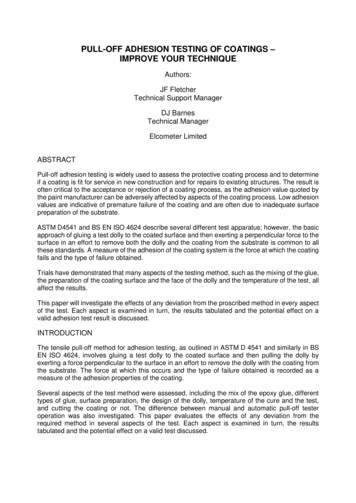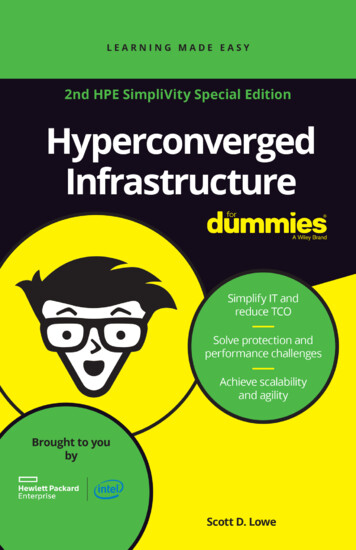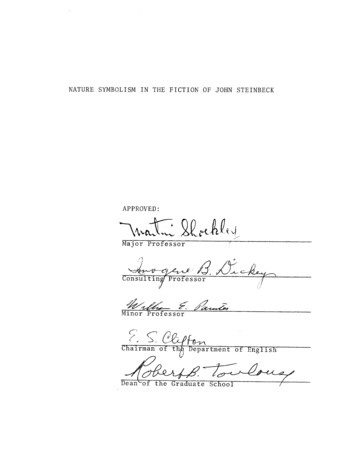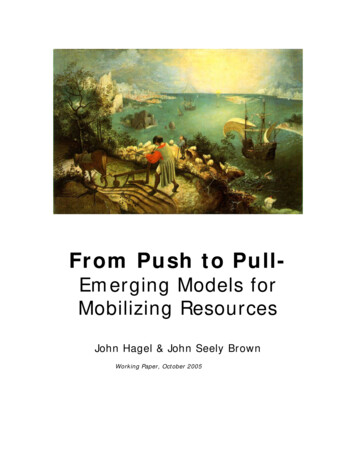
Transcription
From Push to PullEmerging Models forMobilizing ResourcesJohn Hagel & John Seely BrownWorking Paper, October 2005
This working paper represents the beginning of a major new wave of research that willlead eventually to a new book. The perspectives presented here build upon the workcovered in our most recent book, The Only Sustainable Edge: Why Business StrategyDepends on Productive Friction and Dynamic Specialization.If you have not yet had a chance to buy and read this book, we urge you to do so,since it will help you to get a lot more out of this new material.The Only Sustainable Edge explores some of the dynamics unfolding at the edge of thefirm and at the edge of markets (especially focusing on the role of emerging marketslike China and India). But this is only a part of a much broader research agenda thatwe will be pursuing in the months and years ahead.Our point of view is simply stated:the edge is becoming the core.What do we mean by this? The edge is where the action is - in terms of growth,innovation and value creation. Companies, workgroups and individuals that masterthe edge will build a more sustainable core. While our primary focus will be on businessactivity, our perspectives will also be relevant to leaders of other kinds of institutions aswell - educational, governmental and social.The edge is giving rise to a new common sense model.We all perceive and act based on "common sense" assumptions about the world aroundus and the requirements to achieve our goals. Every major technology shift hasproduced a fundamentally new common sense model. Our goal is to understand anddescribe key elements of the new common sense model emerging from technologyinnovations - especially the invention of the microprocessor and the introduction ofpacket-switched networks - that were introduced in the early to mid-1970s.This working paper takes you further down our path of exploration.Sign up for updates atwww.edgeperspectives.comJohn HagelJohn Seely BrownOctober 2005 Copyright 2005 – John Hagel and John Seely Brownwww.johnhagel.com .com www.edgeperspectives.com2
The signs are around us. We are on the cusp of a shift to anew common sense model that will re-shape many facets of ourlife, including how we identify ourselves, participate with others,connect with others, mobilize resources and learn. This paperwill focus on only one facet of this new common sense model –emerging approaches for mobilizing resources.Over the past century, we have been perfecting highly efficientapproaches to mobilizing resources. These approaches mayvary in their details, but they share a common foundation.They are all designed to “push” resources in advance to areasof highest anticipated need. In education, we design standardcurricula to expose students to codified information in a predetermined sequence of experiences. In business, we buildhighly automated plants or service platforms supported bystandardized processes seeking to deliver resources to the rightplace at pre-determined times. In technology, we write massiveenterprise applications specifying activities that must beperformed and resources that must be deployed to meetanticipated demand.In the past decade, we have seen early signs of a new modelfor mobilizing resources. Rather than “push”, this newapproach focuses on “pull” – creating platforms that helppeople to mobilize appropriate resources when the need arises.In lean manufacturing, early elements of a pull model began toemerge from Toyota in the early 1950’s. As we will discussbelow, however, lean manufacturing represents a hybridbetween push and pull models – it still contains significantelements of push models.More fully developed pull models would take several moredecades to emerge in arenas as diverse as media andadvertising, global process networks and education. These arenot just isolated examples - powerful forces are at work Copyright 2005 – John Hagel and John Seely Brownwww.johnhagel.com .com www.edgeperspectives.com3
shaping the need for an alternative approach to mobilizingresources. These forces ensure that this new model will spreadto all arenas of human activity.Pull models are emerging as a response to growing uncertainty.Instead of dealing with uncertainty through tighter control, pullmodels do the opposite. They seek to expand the opportunityfor creativity by local participants dealing with immediate needs.To exploit the opportunities created by uncertainty, pull modelshelp people to come together and innovate in response tounanticipated events, drawing upon a growing array of highlyspecialized and distributed resources. Rather than seeking toconstrain the resources available to people, pull models striveto continually expand the choices available while at the sametime helping people to find the resources that are most relevantto them. Rather than seeking to dictate the actions that peoplemust take, pull models seek to provide people on the peripherywith the tools and resources (including connections to otherpeople) required to take initiative and creatively addressopportunities as they arise. Push models treat people aspassive consumers (even when they are producers like workerson an assembly line) whose needs can be anticipated andshaped by centralized decision-makers. Pull models treatpeople as networked creators (even when they are customerspurchasing goods and services) who are uniquely positioned totransform uncertainty from a problem into an opportunity. Pullmodels are ultimately designed to accelerate capability buildingby participants, helping them to learn as well as innovate, bypursuing trajectories of learning that are tailored to theirspecific needs.By mastering the techniques required to make this new modelwork, companies will be well-positioned to create substantialeconomic value. Those who adhere rigidly to the old model willlikely destroy significant economic value. Copyright 2005 – John Hagel and John Seely Brownwww.johnhagel.com .com www.edgeperspectives.com4
Early Signs of the New ModelAs William Gibson reminds us, “the future is already here, it isjust unevenly distributed”. We are beginning to see early signsof new models for resource mobilization in diverse arenas, frommedia to global process networks to education. Even withinthese arenas, however, the new models are still operating invery early form at the peripheries of more mature push models– often, as in education, they are emerging under the radar, inareas that we would not first think to look.MediaOver the past decade, we have witnessed a transformation ofthe media landscape. On the one hand, mass media isbecoming more concentrated in terms of ownership asaudiences and revenue sources slowly decline. On the otherhand, we are witnessing a blossoming of niche content, aidedby four converging developments: the development of low costand easily accessible content creation tools, the spread of theInternet as an infrastructure for content distribution, thegrowth of new forms of access devices and the emergence ofnew types of distribution businesses facilitating the transition topull models of content distribution.Anything that can be digitized can be accessed and distributedon the Internet. As bandwidth has increased and compressionalgorithms have improved, we have seen a migration from textbased content to music and now to video in terms of using theInternet as a platform for access and distribution. At the sametime more powerful, compact and mobile access devices likeMP3 players and digital video recorders like Tivo are making iteasier to find and connect with relevant content. Copyright 2005 – John Hagel and John Seely Brownwww.johnhagel.com .com www.edgeperspectives.com5
Rather than waiting for media companies to deliver relevantcontent at appropriate times, customers are increasinglyreaching out to pull content to them when they want. They areaided in this task by new distribution businesses that arebreaking down the shelf space constraints of traditionaldistribution channels, radically expanding the range of contentthat is available and providing robust tools to help customersfind the content that is most relevant to them. Sometimesthese new businesses look like more conventional retailers inthe sense of providing a single point of access to broadassortments of media (e.g., Amazon or Netflix). Sometimesthey provide new ways of sampling media before buying (e.g.,Rhapsody). But others are quite different, ranging from eBaywhere the closest analogue is the local flea market to peer topeer networks that lack any central hub at all and enableowners of content to pull from each other directly.But the changes to the media business are not restricted todistribution – pull approaches are also emerging in mediaproduction, leading to a further proliferation in media choices.At the most basic level, younger generations of customers areincreasingly customizing media to better suit their individualneeds. For example, rather than relying on music companies topre-determine the mix of songs on a CD, an increasing numberof music listeners are downloading individual tracks andassembling their own tailored sequence of songs. “Podcasters”are also emerging to share customized selections of music frommany different artists with friends and broader audiences. Avibrant remix culture has also emerged, assisted by widelyaffordable digital audio editing tools, in which DJ’s in night clubsand other music fans recombine and, in some cases, add audiotracks or channels from a recording to produce a modified audiorecording. Copyright 2005 – John Hagel and John Seely Brownwww.johnhagel.com .com www.edgeperspectives.com6
Perhaps the area that has received the most attention recentlyis the rise of blogging. Blogging tools provide everyone withthe capability of quickly “publishing” their perspectives andcreative content like music, photos and even video and makingit broadly available to others. These blogging tools are furtheraugmented by increasingly inexpensive but ever more powerfuldigital content creation tools, ranging from digital still camerasand videocameras (often embedded in mobile telephones foreven more rapid transmission to the Internet) to digital musiccreation and remixing platforms. Media production is no longerthe exclusive province of professionals – talented pro-ams areharnessing these new tools to make their voices heard andcreative talents seen.Blogs also enable everyone to become “editors”, pullingtogether the content of others, remixing it in creative ways andadding commentary. Suddenly, those who never publishedbefore like Joi Ito, editor of the Joi Ito Web blog, and Ana MarieCox, editor of the Wonkette blog, are emerging quickly on theInternet and attracting large audiences. Often, those who areat the cutting edge of inquiry where journals either don’t existor are too slow in getting ideas out find blogs a powerful way toengage in discussions to test and refine their ideas. Theinformal, highly personal style of many blogs also providesinteresting new ways for readers to get a better sense of theperson behind the blog, allowing them to “read” the contentoffered on the blog in a much richer context. All of this varietyand richness available in the blogging world can be accessedand further tailored by the audience through versatileaggregation tools like Technorati and Bloglines.Global Process NetworksAh, but the skeptic will reply, media is different because it canbe digitized and distributed directly over electronic networkslike the Internet. Besides, media has always been a bit of a Copyright 2005 – John Hagel and John Seely Brownwww.johnhagel.com .com www.edgeperspectives.com7
“strange” business, nothing like the work that most enterprisesdo. What about the world of atoms – physical products thatcan’t be produced or distributed on electronic networks?Pull models are also emerging here. Look at the three coreoperating processes of the firm – supply chain management(including manufacturing and logistics), product innovation andcommercialization and customer relationship management.Innovative pull models for organizing activities in theseprocesses across large numbers of enterprises are beginning toemerge in industries as diverse as apparel, motorcycles andcomputers. We describe these pull models as global processnetworks. Many of the most innovative pioneers in developingthese pull models are located in China, but some companies inthe U.S. are beginning to master these pull techniques as well.Perhaps the most sophisticated practitioner of these pull modelson a global scale is a little-known company based in China thathelps apparel designers to configure and operate highlycustomized supply chains to produce and distribute apparel toretailers around the world. This company, Li & Fung, workswith 7,500 business partners in 37 countries to ensure that theright specialized partners are mobilized for a high end woolsweater but then calling on a completely different set ofpartners to produce and distribute synthetic fiber men’s slacks.In sharp contrast to traditional supply chain managers whichhave focused on limiting the number of supply chain partnersand creating tightly integrated operations, the orchestrators ofthese global process networks are rapidly expanding the rangeof participants to provide an even broader range of specializedcapability that can be flexibly “pulled” by individual customersto serve their specific needs.The pull platform created by Li & Fung, bringing togetherthousands of highly specialized business partners from around Copyright 2005 – John Hagel and John Seely Brownwww.johnhagel.com
approach focuses on “pull” – creating platforms that help people to mobilize appropriate resources when the need arises. In lean manufacturing, early elements of a
